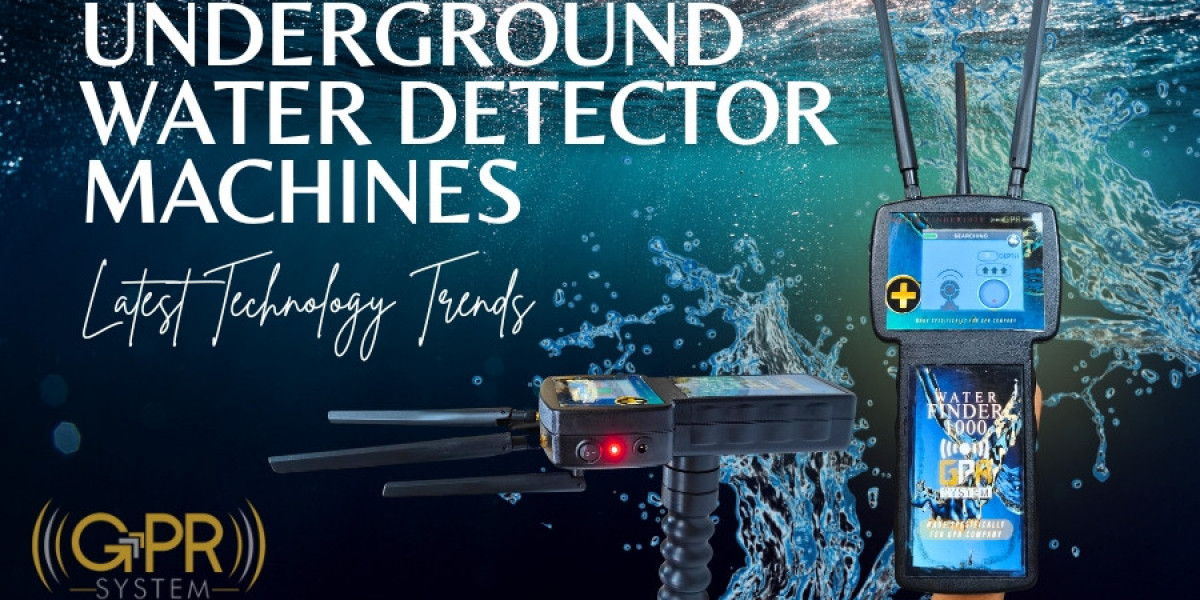Introduction
Finding reliable underground water sources has always been crucial for agriculture, construction, and environmental management. In many regions, access to clean groundwater can determine the success of entire communities or farming operations. Traditional water detection methods often relied on manual expertise or guesswork, leading to inaccurate results and unnecessary expenses.
Today, underground water detector machines have revolutionized this process. With advanced geophysical sensors, AI integration, and 3D imaging technologies, you can now locate underground water sources and tunnels with remarkable precision.
This article explores the latest technology trends in underground water detection. You’ll learn how modern underground water finder devices work, what features to look for, how to choose the right equipment, and why these innovations are transforming how you detect and manage water underground.
Understanding Underground Water Detection Technology
The Science Behind Groundwater Detection
Groundwater lies beneath the earth’s surface, stored in layers called aquifers. Detecting it requires understanding the conductivity, resistivity, and density of the soil and rock formations. Underground water detector machines use electromagnetic, resistivity, and radar-based technologies to read these parameters and locate water-rich zones.
From Dowsing Rods to Digital Scanning
In the past, dowsing rods or manual divining were common for finding water. While these methods were traditional, they lacked scientific reliability. Modern underground water finder devices such as Gold GPR’s detectors now use geophysical principles combined with real-time digital scanning. This transition marks a shift from instinct-based methods to data-driven precision.
How Underground Water Detector Machines Work
1. Electrical Resistivity Measurement
Water conducts electricity better than dry soil or rock. Modern devices measure variations in electrical resistivity to locate zones that may contain groundwater. These readings are displayed as color-coded maps, allowing you to visualize underground structures.
2. Ground Penetrating Radar (GPR)
GPR sends electromagnetic pulses into the ground and records the reflections. When the waves hit water-bearing layers, the signals change. Brands like Gold GPR utilize this method to create 3D subsurface maps, helping you identify both water and underground tunnels accurately.
3. Seismic and Magnetic Sensors
Seismic sensors detect changes in wave velocity, while magnetic sensors pick up mineral composition differences. When combined, these technologies can distinguish between water, rock, and voids vital for locating underground tunnels or aquifers.
4. GPS and AI Integration
Advanced detectors integrate GPS and artificial intelligence to provide automatic location tracking and data analysis. This means you can record, compare, and map water locations over large areas with minimal human error.
Types of Underground Water Detector Machines
1. Resistivity-Based Detectors
Ideal for large-scale projects, these machines measure soil resistance to electric current. They are often used in agricultural and civil engineering applications to identify groundwater depth and quality.
2. Electromagnetic Induction Devices
These lightweight devices generate magnetic fields and detect changes caused by water-bearing formations. They are portable, accurate, and excellent for preliminary surveys.
3. Ground Penetrating Radar Units
Used in professional and industrial applications, GPR-based machines from Gold GPR are known for high precision. They can detect not only underground water but also underground tunnels, voids, and metallic objects.
4. Multisensor Smart Detectors
These integrate multiple technologies resistivity, radar, and seismic sensors into one device. They offer advanced 3D imaging, AI-based interpretation, and real-time reporting.
Latest Trends in Underground Water Detection
1. Artificial Intelligence and Data Analytics
AI now plays a major role in interpreting subsurface data. It can analyze soil resistivity, radar reflections, and GPS data to predict water presence more accurately. You can make faster, data-backed decisions without relying on manual readings.
2. 3D and 4D Mapping Technology
Next-generation underground water finder devices produce 3D maps of aquifers and tunnels. Some advanced systems now integrate 4D mapping, allowing time-based monitoring of groundwater changes.
3. Mobile Connectivity and Cloud Integration
Modern devices sync with mobile apps and cloud systems, allowing you to access real-time data from anywhere. Teams can collaborate remotely, view reports instantly, and compare readings across sites.
4. Energy-Efficient and Eco-Friendly Designs
Manufacturers now focus on energy-efficient sensors and rechargeable systems. These machines are lighter, more portable, and consume less power, making them sustainable for long-term field use.
5. AI-Driven Predictive Modeling
By combining environmental and geological datasets, predictive AI models can forecast potential water zones even before field deployment. This saves both time and operational costs.
6. Integration with Drone Technology
Drone-assisted surveys combined with ground-based sensors are emerging as a major trend. Drones can scan large terrains quickly, and when paired with underground tunnel detectors, they create a complete surface-to-depth map.
Benefits of Using Modern Underground Water Detector Machines
1. High Accuracy and Speed
Modern detectors like those from Gold GPR deliver fast and reliable readings, reducing human error and ensuring accurate results within minutes.
2. Cost-Effective Water Exploration
Instead of drilling multiple test wells, you can use these detectors to identify the most promising locations first, saving resources and time.
3. Eco-Friendly Detection
Since modern devices use non-invasive methods like radar or resistivity imaging, they don’t disturb the environment during operation.
4. Versatility Across Applications
These machines are not just for water detection. They also help detect underground tunnels, cavities, and geological faults making them useful for civil engineers, archaeologists, and miners.
5. Real-Time Visualization
With live mapping and imaging, you can instantly interpret subsurface structures and make informed drilling or excavation decisions.
Choosing the Right Underground Water Detector
1. Detection Depth and Range
Determine how deep you need to detect water. Entry-level devices may reach 100 meters, while advanced systems can detect depths beyond 1000 meters.
2. Technology Type
If you need precision mapping, go for GPR-based machines. For large agricultural fields, resistivity or electromagnetic detectors may be more cost-effective.
3. Portability and Power
For field surveys, lightweight, battery-operated models are essential. Ensure your machine supports long working hours and quick recharging.
4. Data Storage and Integration
Look for devices with built-in memory, cloud backup, or mobile connectivity. Gold GPR detectors, for instance, allow seamless data transfer for later analysis.
5. Brand Reliability and Support
Choose reputable brands known for calibration accuracy, durability, and after-sales support. Gold GPR stands out for its technical service network and consistent innovation.
Common Applications
1. Agriculture and Irrigation Planning
Farmers use underground water detector machines to identify reliable groundwater sources for irrigation, ensuring optimal crop yield and sustainable farming.
2. Construction and Civil Engineering
Engineers depend on these devices to locate underground water that may affect foundations, tunnels, or road structures. Detecting hidden aquifers early prevents costly structural damage.
3. Mining and Exploration
Water detection is critical in mining safety. GPR and seismic-based detectors identify water-bearing zones that could lead to flooding or instability in tunnels.
4. Environmental and Hydrogeological Studies
Scientists use water detection data to analyze aquifer health, recharge potential, and groundwater contamination levels.
5. Archaeological and Tunnel Detection
The same machines that locate underground water can detect underground tunnels, hidden chambers, or voids, making them valuable tools in archaeology and security operations.
Maintenance and Best Practices
1. Calibration and Testing
Regular calibration ensures accurate readings. Follow manufacturer guidelines and test your equipment before field use.
2. Environmental Adjustments
Moisture, temperature, and soil type can influence readings. Calibrate the device according to environmental conditions.
3. Proper Storage
Keep your equipment in a dry, dust-free environment. Recharge batteries after every field operation.
4. Data Backup
Always save readings and maps to the cloud or external storage for future reference or analysis.
5. Operator Training
Even advanced systems require skilled handling. Training ensures you interpret readings correctly and avoid misidentification.
Challenges in Underground Water Detection
1. Complex Geology
Different soil and rock compositions can distort readings. Using multisensor systems helps overcome this challenge.
2. Environmental Noise
Electrical interference or vibration can affect sensor accuracy. Modern devices include filtering software to minimize these effects.
3. Cost of High-End Systems
While advanced detectors are more accurate, they can be expensive. However, the long-term savings from reduced drilling costs often outweigh the investment.
4. Data Interpretation
Without proper training, interpreting complex radar or resistivity data can be difficult. AI-powered systems now simplify this process by providing auto-analysis.
The Role of Gold GPR in Modern Water Detection
Gold GPR has become a trusted name in subsurface exploration technologies. Their detectors combine GPR, resistivity, and AI-based analysis to provide high-precision results for both underground water and underground tunnel detection.
With user-friendly interfaces, durable construction, and real-time data visualization, Gold GPR devices empower you to make faster, more confident decisions in the field. Whether you’re a farmer, engineer, or geophysical researcher, these machines offer unmatched reliability.
The Future of Underground Water Detection
1. Smarter AI Models
Future detectors will use predictive AI to forecast underground water presence based on satellite data and environmental conditions.
2. IoT and Remote Monitoring
IoT-based water detectors will transmit data to remote servers, allowing long-term monitoring of groundwater levels without manual surveys.
3. Portable Wearable Scanners
Miniaturized sensors will soon make portable scanners a reality. These handheld tools will allow instant water detection with minimal setup.
4. Hybrid Detection Systems
Next-gen systems will merge drone imaging, ground radar, and seismic sensors for a 360° view of subsurface structures.
5. Sustainability-Focused Designs
Eco-friendly materials, solar-powered sensors, and low-impact scanning methods will define the next phase of development.
Conclusion
The field of underground water detector machines is evolving rapidly. With technologies like AI, GPR, and cloud-based analytics, detecting underground water has become faster, more precise, and sustainable. Whether you’re searching for groundwater for agriculture or mapping underground tunnels for construction safety, modern underground water finder devices provide unmatched accuracy and insight.
Choosing a reliable brand like Gold GPR ensures you benefit from advanced features, durable design, and continuous innovation. As technology advances, the future promises even more intelligent, energy-efficient, and user-friendly solutions for all your water detection needs.







